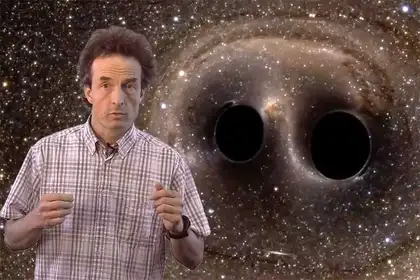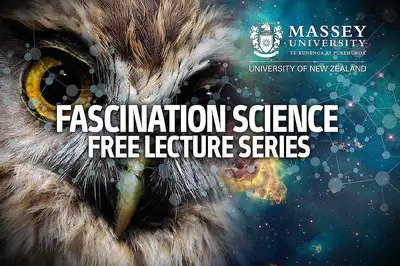
Professor Joachim Brand behind two black holes merging.
Have you ever wondered what it would sound like to hear two black holes merging? Though it may not compete with Lorde’s latest release, it is music to the ears of scientists who have been searching for evidence of gravitational waves ever since Albert Einstein predicted their existence with his general theory of relativity.
A Massey University theoretical physicist will explain the nature and origin of the waves, how they were captured and what it might mean for the future of astronomy, in the fourth of a free lecture series held at the Massey University’s Albany campus, as part of the ‘Fascination Science’ series.

Free lecture series at Massey Albany.
Ripples in the fabric of space-time
Professor Joachim Brand, of Massey’s New Zealand Institute for Advanced Study, says these waves are “literally ripples in the fabric of space-time caused by violent expenditures of energy.”
“Einstein theorised that massive objects accelerating at high speeds, like black holes merging, would disrupt space-time and that this event would send ripples out from the source to travel across space – called gravitational waves. The prediction of these waves kept scientists wondering and trying to detect them for a century without any luck.
Einstein himself later doubted these predictions, and even tried to disprove them at one stage, but never lived to see them verified by experiment. The discovery in 2015 not only served as another verification of Einstein's theory, but it also ushered in a new era for astronomy.”
Professor Brand will delve into the technology that made their detection possible and the development of quantum technologies that will make future detectors even more sensitive.
“Listening for gravitational waves is similar to detecting earthquakes by recording the earth’s vibrations.
You can learn a lot about the quake and what caused it by carefully analysing the signals that it causes.”
Gravitational waves were observed for the first time in late 2015 and again last year, using a technique called laser interferometry.
“The technique uses a laser beam that is split and the two halves are recombined after travelling different paths. We can measure whether one arm of the beam has stretched to become longer than the other one, which is what happens when a gravitational wave passes through one of the beams. The problem is that gravitational waves are so minute, that so far we have been able to just detect one of the most violent events – the merging of two black holes into one.
“This observation is very important because we cannot see black holes with telescopes. If we further improve the technology, and grow ‘bigger ears’ for gravitational waves, we may someday listen to the echo of the big bang itself.”
The future developments in gravitational wave detection are poised to require quantum technology, which is closely linked to Professor Brand’s research interests as a quantum physicist. With his students and collaborators he is currently devising table-top simulators of early Universe models, where the popping up of universes, and their possible mergers, are emulated with ultra-cold atomic gases. The results of such experiments, together with future detections of gravitational waves, may one day give us a clearer picture of how our Universe came into existence.
Lecture details
Gravitational waves: Listening in to the sounds of the universe – Professor Joachim Brand
Tuesday, March 28, 7.00-8.30pm, Sir Neil Waters Lecture Theatres, Massey University Auckland Campus, Albany.
For more information or to register to attend, go to http://massey.ac.nz/fascination-science